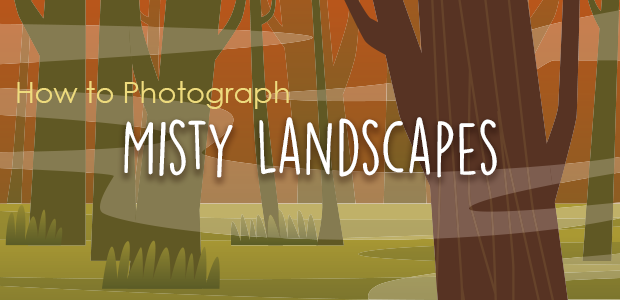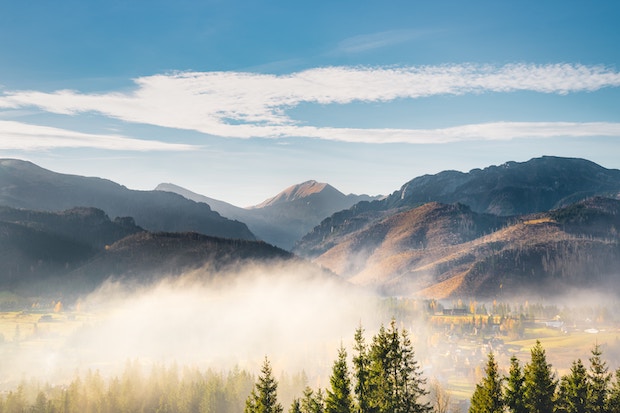Envira Gallery Blog
Digital Photography Tips, Tutorials and Resources
Digital Photography Tips, Tutorials and Resources

Last updated on May 28, 2024 by [email protected]
Have you wanted to create beautiful images of misty landscapes? Photographing fog, wet weather, and misty landscapes can be one of the most challenging landscape photography situations. There are a number of technical challenges involved in creating a compelling image in wet weather.
To create a strong image, photographers have to balance a number of different settings, including:
This guide will first cover the challenges involved in photographing mist and wet weather, tips for overcoming the challenges, the needed equipment to create those images, and finally, the best camera settings to use as a starting point.
The very nature of mist — that ethereal, delicate quality of light — makes it difficult to photograph. Mist typically looks best in either very low contrast or very high contrast situations, where it appears soft or very dramatic, respectively. These extremes of lighting require very different settings, meaning photographers have to be comfortable using a range of shutter speeds.
In order to capture mist, photographers also have to be comfortable adjusting their camera and lens in rapidly changing situations. Light suddenly breaking through mist can mean big changes in exposure. And, autofocus may not work well with a low-contrast subject.
The challenges in photographing misty landscapes are worth it, however. In fact, you can apply the same techniques to other subjects, including waterfalls. Understanding how shutter speed impacts the appearance of fog and mist also translates to other moving subjects.
Choosing a proper shutter speed is one of the major challenges in photographing fog and mist. While a slow shutter speeds can smooth out the appearance of moving fog, too slow can render your subject blurry. This is particularly true if other objects in the scene are also moving.
A good misty landscape photo can have a number of different looks. You have a number of options, including focusing on the mist or using water droplets in a macro shot. Each of these looks will require different settings and choices on the part of the photographer.
The following are some general tips for photographing misty landscapes:
When getting started, try a range of shutter speeds, from slow to fast. Different speeds will give different looks.
A slow shutter speed will give a softer look to the fog. But, you’ll need to make sure you use a tripod to prevent camera shake. A fast shutter speed, on the other hand, will help freeze fog. Fast shutter speeds can also help you expose for the highlights to create high contrast.
A long exposure technique is also useful to learn for other wet environments. Try out a long exposure on flowing water, waves breaking on the beach, or a waterfall for great results.
The trick to this tip isn’t just to use a wide angle lens, but to get close while doing so. As we mentioned in our guide to lenses for landscape photography, using a wide-angle lens can deliver a dramatic look for landscape photography. When you get close to your subject with a wide-angle lens, the apparent size of your foreground objects increases. This can help turn a small fog bank into an impressive visual element.
It isn’t always practical to get in close, especially when the weather is changing quickly. A telephoto lens can be great for isolating visually interesting cloud formations or highlighting a dramatic fog bank.
Regardless of which focal length you’re using, keep your front lens element clean. While water droplets in the photo can look great, droplets on the lens can cause blur or reduced contrast. A clean cloth or blower can remove stray drops easily.
But, if you shoot in wet weather frequently, a clear filter is a better option. Clear filters can give you an easier, cheaper surface to clean.
A good image of mist is really about the mist’s interaction with the light surrounding it. Unique lighting can take a mist and fog photo to another level. This is true whether you’re dealing with soft, cozy light during early mornings or bright sunbeams in the afternoon.
While having a gorgeous and unique subject can make for an interesting photo regardless of composition, don’t throw away the compositional guidelines you already know. Using the rule of thirds and keeping a clean frame are still important when shooting mist landscape photos. For more information, check out our guide to composition.

Fortunately, the equipment you’ll need to photograph misty landscapes isn’t anything unique. If you already have the gear for landscape or travel photography, you can create great misty landscape photos already.
If you want to get into this style of photography, you’ll want to have a wide-angle lens, telephoto lens, and a tripod. You can create images of fog and mist with any gear, but these essentials will give you the most creative control.
Since these subjects aren’t moving quickly, you shouldn’t need to worry about forcing a fast shutter speed. This is an issue with animals or other subjects in action. Misty subjects allow you to use slower shutter speeds, narrower aperture settings, and even to manually focus.
As a result, you can use manual focus lenses or older gear, without any issue.
If you aren’t shooting raw, make sure to be careful when setting your white balance. The white balance, which changes how “warm” or “cool” an image appears, will have a drastic impact on fog photos, since they are largely white and grey. Try different white balance settings to create different looks, particularly if you are shooting raw files.
When shooting in misty environments, consider getting some rain protection for your camera. Simple poncho-style covers can go a long way to reducing the amount of water on the camera. This is particularly important if your camera isn’t weather sealed.
Along with a rain cover, consider adding a clear or neutral front filter to your lens. This prevents water from pooling on your front element. Reducing the number of places water can get in can help keep your camera from malfunctioning.
Regardless of what wet and misty scene you want to capture, keep in mind the importance of shutter speed. Photographing misty landscapes comes down to choosing the right shutter speed and white balance for the emotion you’re trying to capture.
While you don’t need much specialized equipment, make sure to protect your lens and camera from water. Cameras are electronics, just like your phone or computer. Keep them safer with filters and other rain protection when photographing misty landscapes.
We hope you’ve learned something from this tutorial on photographing misty landscapes! Consider following us on Twitter and Facebook for more landscape photography tutorials if you enjoyed this guide!
Envira Gallery helps photographers create beautiful photo and video galleries in just a few clicks so that they can showcase and sell their work.
